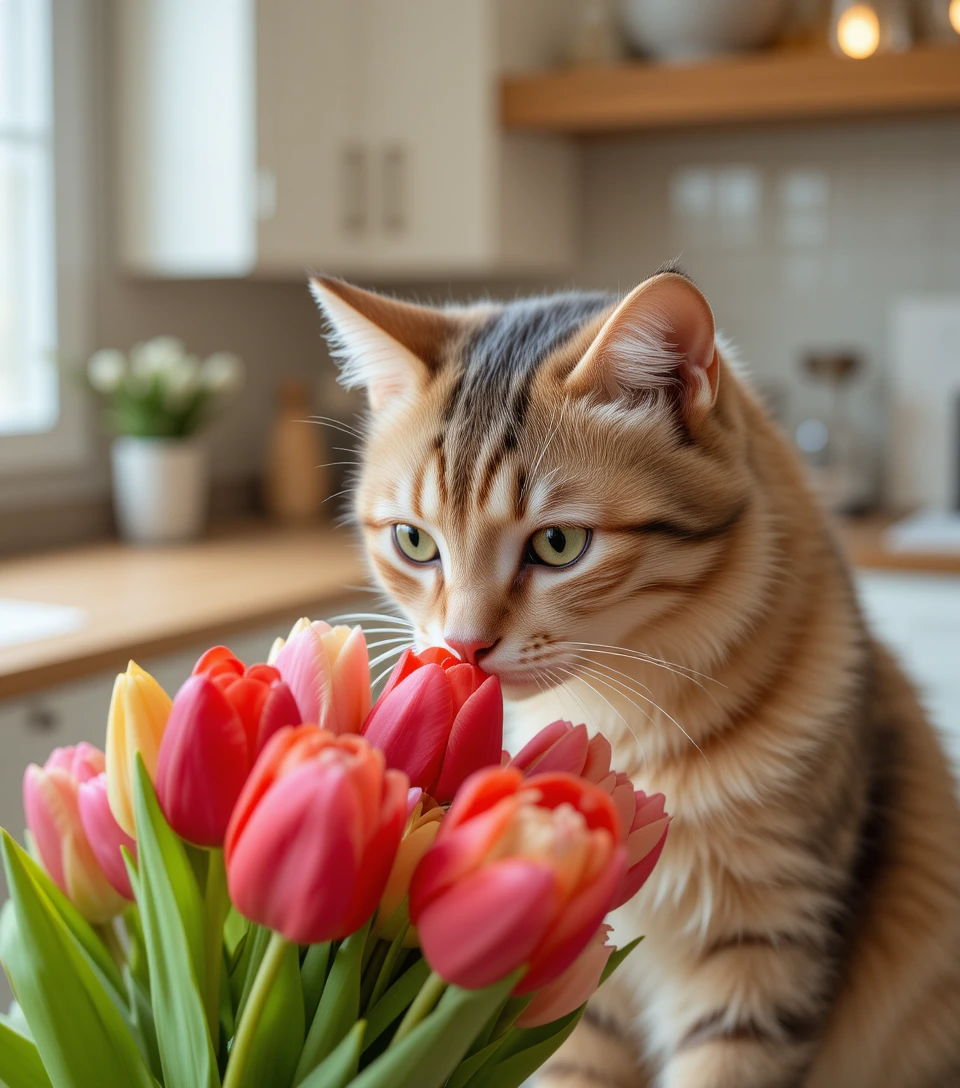🌷 Introduction: The Hidden Danger in Your Vase
Tulips may brighten up your home, but if you’re a cat parent, these springtime favorites can pose a serious risk. While their colorful petals seem harmless, tulips contain toxins that are highly poisonous to cats. Whether your cat is curious, playful, or simply looking for a snack, even a nibble could lead to dangerous symptoms. Let’s dive into why tulips can be hazardous—and how to protect your feline friend now.
❗ Are Tulips Poisonous to Cats? Absolutely, Yes.

According to the ASPCA and veterinary toxicology experts, tulips are toxic to cats. The primary culprits are two chemical compounds found in the plant: tulipalin A and tulipalin B. These natural toxins are present throughout the plant but are especially concentrated in the bulbs.
Even small exposures—like chewing a leaf or licking pollen—can lead to health issues. That’s why pet parents must act fast when tulips and cats share the same space.
🧪 Why Tulips Are Toxic to Cats
Tulipalin A and B, the toxic glycosides found in tulips, can irritate a cat’s mouth and stomach. Once ingested, they may cause a range of symptoms from gastrointestinal upset to nervous system problems.
The most toxic part?
- The bulbs (underground part)
- Followed by leaves and petals
Even cut tulips in a vase can pose a threat, especially if your cat drinks the water they’re sitting in.
🚨 Symptoms of Tulip Poisoning in Cats
If your cat has come into contact with or eaten tulip parts, watch for these common warning signs:
- Drooling
- Vomiting
- Diarrhea
- Lethargy
- Loss of appetite
- Pawing at the mouth
- Tremors (in severe cases)
If any of these symptoms appear, it’s time to act quickly.
🩺 What to Do If Your Cat Eats a Tulip

Step 1: Stay Calm but Act Fast
Don’t induce vomiting without veterinary advice—it can cause more harm than good.
Step 2: Remove Plant Access
Gently take the tulip away and wipe your cat’s mouth with a damp cloth if possible.
Step 3: Contact Your Vet or Pet Poison Hotline Immediately
- ASPCA Animal Poison Control Center: 1-888-426-4435
- Pet Poison Helpline: 1-855-764-7661
Prompt treatment can prevent complications like dehydration or organ damage.
🛡️ How to Keep Your Cat Safe from Toxic Plants
Protecting your cat means taking preventive steps:
- Keep tulips and other toxic plants out of reach
- Avoid growing tulips indoors or in areas your cat roams freely
- Use barriers or plant covers for outdoor gardens
- Don’t place bouquets within jumping or climbing distance
Even better, go tulip-free altogether if you have a particularly curious cat.
🌼 Safe Alternatives to Tulips for Cat Owners
Looking for pet-safe plants that won’t compromise your décor? Try these beautiful, non-toxic alternatives:
- African violets
- Orchids
- Spider plants
- Bromeliads
- Areca palms
- Calatheas
- Snapdragons
These are just as gorgeous—without the guilt or risk.
🧠 Preventive Tips for Cat Parents

Being proactive can save you stress—and vet bills. Here’s how to stay ahead:
- Research plants before buying
- Use cat-repellent sprays on indoor greenery
- Set up a dedicated cat-safe zone with edible plants like cat grass
- Train your cat to avoid chewing on foliage
- Share this info with friends and family who send flowers your way
✅ Conclusion: Better Safe Than Sorry
Tulips are undeniably beautiful, but when it comes to cats, they’re best admired from afar. Whether you’re decorating for spring or planting a garden, being informed can make all the difference. Stay aware, stay cautious, and choose pet-friendly blooms that keep your furry friend safe—and your home just as lovely.
❓ 10 Frequently Asked Questions (FAQs)
- Can tulip petals harm my cat, or just the bulbs?
The entire plant is toxic, but the bulbs contain the highest concentration of tulipalin toxins. - How much tulip is dangerous for a cat?
Even small amounts can trigger symptoms. Severity depends on the amount ingested and your cat’s size. - What should I do immediately after my cat eats a tulip?
Remove access, clean your cat’s mouth gently, and contact your vet or a poison control hotline. - Are all types of tulips toxic to cats?
Yes, all tulip species and cultivars contain the same toxic compounds. - How long does it take for symptoms to appear in cats?
Usually within a few hours, but some signs can be delayed. Monitor your cat for at least 24 hours. - Can tulip poisoning be fatal in cats?
It’s rare, but in severe cases—especially if untreated—it can lead to life-threatening complications. - Are other spring flowers also dangerous to pets?
Yes, daffodils, lilies, and hyacinths are also toxic to cats and dogs. - How can I make my home safe for indoor cats?
Stick to non-toxic plants, use cat deterrents, and keep any flowers high and out of reach. - What are some vet-approved cat-safe flowers?
African violets, roses, orchids, and snapdragons are among the most recommended. - Is it safe to grow tulips if I have an outdoor cat?
It’s risky—consider fencing off garden beds or using alternative plants if your cat roams freely.

